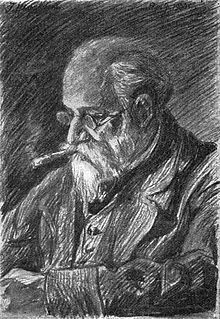Adolf Iossifowitsch Charlemagne

Adolf Iosifovich Charlemagne , also Charlemagne-Baudet and Baudet-Charlemagne , ( Russian Адольф Иосифович Шарлемань, Шарлемань-Боде, Боде-Шарлемань ; born December 8 . Jul / 20th December 1826 greg. In St. Petersburg , † January 31 jul . / February 13, 1901 greg. Ibid) was a Russian painter .
Life
Charlemagne's father was the architect Iossif Ivanovich Charlemagne . Charlemagne's grandfather Jean Baptiste Charlemagne-Baudet was a sculptor in Rouen and came to St. Petersburg in 1777 at the invitation of Catherine II . Charlemagne attended the German Petri School and began studying at the Imperial Academy of Arts in 1848 . He studied at Fyodor Bruni , the history painting and then the battle painting at Bogdan Willewalde . In 1852, together with his brother Iossif Iossifowitsch Charlemagne, he founded a small society of young people, artists and art lovers who met in the evenings to draw. This resulted in the so-called Watercolor Fridays . Charlemagne received the small silver medal from the Imperial Academy of Arts in 1852 for the study of the cavalry guard in Krasnoye Selo , in 1853 the large silver medal for the painting Episode of the Battle of Austerlitz , in 1854 the small gold medal for the competition program for the Russian campaign in Hungary in 1848 and in 1855 the Large gold medal for the painting Alexander Wassiljewitsch Suworow on the Gotthard Pass for Gatchina Castle . The Grand Gold Medal was linked to a foreign scholarship from the Academy of Arts, with which Charlemagne traveled to Munich . There he followed Alexander von Kotzebue's advice and painted other Suvorov pictures, for which he was accepted as a member of the Imperial Academy of Arts in 1859. He then traveled to Paris , where he studied the Rococo and the style of Madame de Pompadour in his Versailles paintings . He visited Stuttgart and other German cities and returned to St. Petersburg in 1861.
Charlemagne's first works after his return were pictures for the Catholic churches on the page corps building and on the cemetery on the Vyborg side . This was followed by ceiling and wall paintings for Prince Meschtscherskis' house in Moscow and A. Poleschajew's house in St. Petersburg. In 1867 he was appointed professor at the Imperial Academy of Arts for his painting Catherine II in Étienne-Maurice Falconet's workshop , which the Empress Marija Alexandrovna acquired.
Charlemagne's pictures were used by publishers as templates for illustrations for books and magazines. From 1871 Charlemagne served as an artist for the main administration of the state printing house for the production of documents, banknotes and stamps in particular. In the same year he became a consultant for the production of an album of military pictures for Alexander II. In 1873 he was awarded the title of Artist of His Imperial Majesty .
Charlemagne was married to Jelisaveta Ivanovna, daughter of the painter and owner of a photo studio on Nevsky Prospect Ivan Andreevich Goch . Charlemagne was the great uncle of the painter Lidija Ivanovna Charlemagne .
Charlemagne was buried in St. Petersburg in the Vyborg Catholic Cemetery. His grave has not been preserved.
Works
Suvorov in Milan
Uniforms of the lackeys of the imperial court (1855)
Pugachev's execution (1855)
Villa Berg in Stuttgart
Grand Duke Konstantin Nikolajewitsch's children ice-skating
Celebration of the 25th anniversary of the Tsarskoye Selo Railway in the Pavlovsk Railway Station
Playing cards (1862)
Storming of the Gjandscha fortress on January 3, 1804 (Illustration of the history of the 13th Life Guard Regiment, 1893)
The great deed of the soldier Petrov in the Finnish war
Individual evidence
- ↑ a b c d Шарлемань (Адольф Иосифович, 1826–1901) . In: Brockhaus-Efron . tape XXXIX , 1903, p. 178 ( s: ru: ЭСБЕ / Шарлемань, Адольф Иосифович [accessed August 13, 2018]).
- ↑ Biografija.ru: Шарлемань Боде Адольф Иосифович (accessed August 13, 2018).
- ↑ a b Kartotschny domik: Шарлемань Адольф Иосифович (accessed August 13, 2018).
- ↑ МОГИЛЕВСКИЙ, 26-й пех., Полк . In: Военная энциклопедия (Сытин, 1911–1915) . tape 16 , 1903, pp. 375–376 ( s: ru: ВЭ / ВТ / Могилевский, 26-й пехотный, полк [accessed August 13, 2018]).
| personal data | |
|---|---|
| SURNAME | Charlemagne, Adolf Iossifowitsch |
| ALTERNATIVE NAMES | Charlemagne-Baudet, Adolf Iossifowitsch; Baudet-Charlemagne, Adolf Iossifowitsch; Шарлемань, Адольф Иосифович (Russian) |
| BRIEF DESCRIPTION | Russian painter |
| DATE OF BIRTH | December 20, 1826 |
| PLACE OF BIRTH | St. Petersburg |
| DATE OF DEATH | February 13, 1901 |
| Place of death | St. Petersburg |









